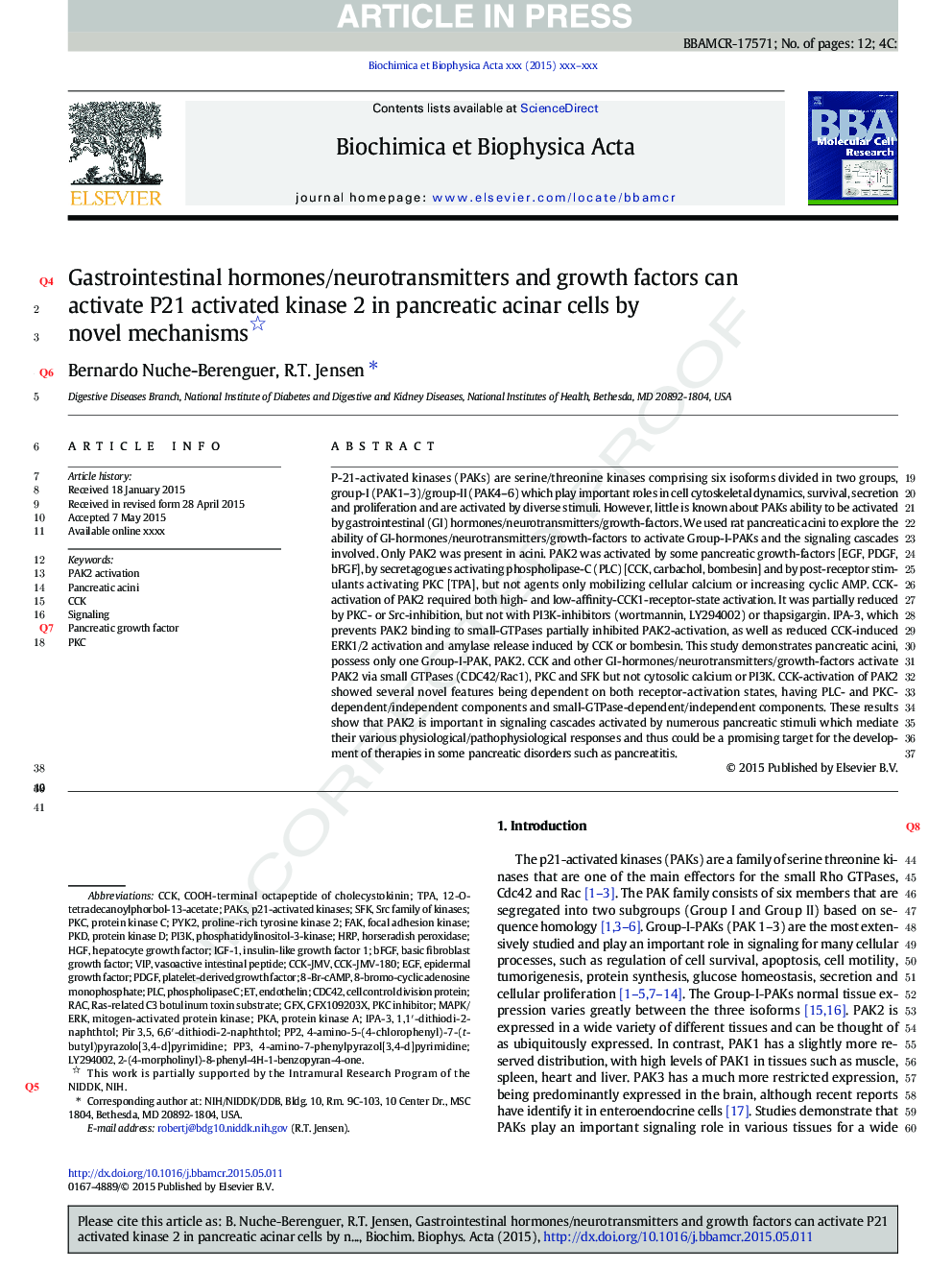| کد مقاله | کد نشریه | سال انتشار | مقاله انگلیسی | نسخه تمام متن |
|---|---|---|---|---|
| 10801937 | 1055649 | 2015 | 12 صفحه PDF | دانلود رایگان |
عنوان انگلیسی مقاله ISI
Gastrointestinal hormones/neurotransmitters and growth factors can activate P21 activated kinase 2 in pancreatic acinar cells by novel mechanisms
دانلود مقاله + سفارش ترجمه
دانلود مقاله ISI انگلیسی
رایگان برای ایرانیان
کلمات کلیدی
PKDPLCPKCPYK2PDGFCDC42HGFPP2LY294002SFKGFX8-br-cAMPp21-Activated kinasesPP32-(4-morpholinyl)-8-phenyl-4H-1-benzopyran-4-one4-amino-5-(4-chlorophenyl)-7-(t-butyl)pyrazolo[3,4-d]pyrimidineCCK-JMV-1808-Bromo-cyclic adenosine monophosphateVIPPI3KEGFRACtPAbFGFHRPFAK12-O-tetradecanoylphorbol-13-acetatepKaIGF-1CCKMAPK/ERK - MAPK / ERKPancreatic acini - آکانی پانکراسendothelin - اندوتلینproline-rich tyrosine kinase 2 - تریستین کیناز غنی از پرولین 2Signaling - سیگنالینگepidermal growth factor - عامل رشد اپیدرمیHepatocyte growth factor - عامل رشد هپاتوسیتplatelet-derived growth factor - فاکتور رشد حاصل از پلاکتbasic fibroblast growth factor - فاکتور رشد فیبروبلاست پایهinsulin-like growth factor 1 - فاکتور رشد مانند انسولین 1phosphatidylinositol-3-kinase - فسفاتیدیلینواستیل-3-کینازphospholipase C - فسفولیپاز CRAS-related C3 botulinum toxin substrate - وابسته به RAS وابسته به سم بوتولینوم توکسینHorseradish peroxidase - پراکسیداز هوررادیشprotein kinase A - پروتئین کیناز Aprotein kinase D - پروتئین کیناز DProtein kinase C - پروتئین کیناز سیmitogen-activated protein kinase - پروتئین کیناز فعال با mitogenvasoactive intestinal peptide - پپتید روده روده ایfocal adhesion kinase - کیناز چسبندگی کانونی
موضوعات مرتبط
علوم زیستی و بیوفناوری
بیوشیمی، ژنتیک و زیست شناسی مولکولی
زیست شیمی
پیش نمایش صفحه اول مقاله

چکیده انگلیسی
P-21-activated kinases (PAKs) are serine/threonine kinases comprising six isoforms divided in two groups, group-I (PAK1-3)/group-II (PAK4-6) which play important roles in cell cytoskeletal dynamics, survival, secretion and proliferation and are activated by diverse stimuli. However, little is known about PAKs ability to be activated by gastrointestinal (GI) hormones/neurotransmitters/growth-factors. We used rat pancreatic acini to explore the ability of GI-hormones/neurotransmitters/growth-factors to activate Group-I-PAKs and the signaling cascades involved. Only PAK2 was present in acini. PAK2 was activated by some pancreatic growth-factors [EGF, PDGF, bFGF], by secretagogues activating phospholipase-C (PLC) [CCK, carbachol, bombesin] and by post-receptor stimulants activating PKC [TPA], but not agents only mobilizing cellular calcium or increasing cyclic AMP. CCK-activation of PAK2 required both high- and low-affinity-CCK1-receptor-state activation. It was partially reduced by PKC- or Src-inhibition, but not with PI3K-inhibitors (wortmannin, LY294002) or thapsigargin. IPA-3, which prevents PAK2 binding to small-GTPases partially inhibited PAK2-activation, as well as reduced CCK-induced ERK1/2 activation and amylase release induced by CCK or bombesin. This study demonstrates pancreatic acini, possess only one Group-I-PAK, PAK2. CCK and other GI-hormones/neurotransmitters/growth-factors activate PAK2 via small GTPases (CDC42/Rac1), PKC and SFK but not cytosolic calcium or PI3K. CCK-activation of PAK2 showed several novel features being dependent on both receptor-activation states, having PLC- and PKC-dependent/independent components and small-GTPase-dependent/independent components. These results show that PAK2 is important in signaling cascades activated by numerous pancreatic stimuli which mediate their various physiological/pathophysiological responses and thus could be a promising target for the development of therapies in some pancreatic disorders such as pancreatitis.
ناشر
Database: Elsevier - ScienceDirect (ساینس دایرکت)
Journal: Biochimica et Biophysica Acta (BBA) - Molecular Cell Research - Volume 1853, Issue 10, Part A, October 2015, Pages 2371-2382
Journal: Biochimica et Biophysica Acta (BBA) - Molecular Cell Research - Volume 1853, Issue 10, Part A, October 2015, Pages 2371-2382
نویسندگان
Bernardo Nuche-Berenguer, R.T. Jensen,